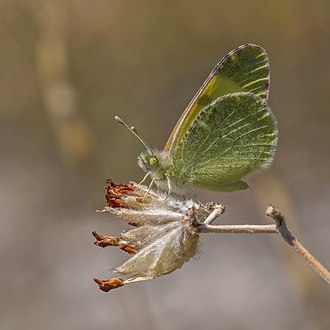Pieridae




Pieridae is a large family of butterflies known for their distinctive bright colors, often in shades of yellow, orange, and white, which contribute to their common names such as "yellows" and "whites." This family includes some of the most familiar butterfly species seen in gardens and fields across the world. The Pieridae family is significant both ecologically and scientifically, playing crucial roles in pollination and serving as model organisms in genetic and evolutionary studies.
Characteristics[edit]
Members of the Pieridae family typically have wings that are white, yellow, or orange with black spots or edges. The bright colors serve as a warning to predators about their potential bitterness or toxicity, a defense mechanism known as aposematism. The larvae, or caterpillars, of Pieridae species are herbivorous, feeding on a wide range of host plants, often from the Brassicaceae, Fabaceae, and Tropaeolaceae families. These feeding habits can sometimes make them agricultural pests.
Classification[edit]
The family Pieridae is divided into several subfamilies, with the most well-known being the Coliadinae (sulphurs or yellows) and Pierinae (whites or cabbage butterflies). Each subfamily is further divided into tribes and genera, encompassing a diverse range of species.
Subfamilies[edit]
- Coliadinae - Known as the sulphurs, these are generally yellow or orange with lighter undersides to camouflage against the sky.
- Pierinae - This group includes the whites and cabbage butterflies, often characterized by their white wings with black spots.
Distribution and Habitat[edit]
Pieridae butterflies are found worldwide, from tropical rainforests to temperate regions. They are adaptable and can inhabit a variety of environments, including meadows, fields, gardens, and forest edges. Their widespread distribution makes them one of the most recognizable butterfly families.
Behavior[edit]
Pieridae butterflies exhibit a range of behaviors that are typical of Lepidoptera. They are diurnal, active during the day when they feed on nectar from flowers. Their flight patterns can be erratic, making them difficult for predators to capture. Mating rituals involve visual displays, where males show off their bright colors to attract females.
Conservation[edit]
While many Pieridae species are common and not currently at risk, habitat destruction and climate change pose threats to their populations. Conservation efforts focus on preserving natural habitats and promoting biodiversity to ensure the survival of these important pollinators.
In Culture[edit]
Due to their bright colors and frequent presence in gardens, Pieridae butterflies have been admired and celebrated in various cultures. They are often associated with themes of transformation, beauty, and the arrival of spring.
Ad. Transform your life with W8MD's Budget GLP-1 injections from $75


W8MD offers a medical weight loss program to lose weight in Philadelphia. Our physician-supervised medical weight loss provides:
- Weight loss injections in NYC (generic and brand names):
- Zepbound / Mounjaro, Wegovy / Ozempic, Saxenda
- Most insurances accepted or discounted self-pay rates. We will obtain insurance prior authorizations if needed.
- Generic GLP1 weight loss injections from $75 for the starting dose.
- Also offer prescription weight loss medications including Phentermine, Qsymia, Diethylpropion, Contrave etc.
NYC weight loss doctor appointmentsNYC weight loss doctor appointments
Start your NYC weight loss journey today at our NYC medical weight loss and Philadelphia medical weight loss clinics.
- Call 718-946-5500 to lose weight in NYC or for medical weight loss in Philadelphia 215-676-2334.
- Tags:NYC medical weight loss, Philadelphia lose weight Zepbound NYC, Budget GLP1 weight loss injections, Wegovy Philadelphia, Wegovy NYC, Philadelphia medical weight loss, Brookly weight loss and Wegovy NYC
|
WikiMD's Wellness Encyclopedia |
| Let Food Be Thy Medicine Medicine Thy Food - Hippocrates |
Medical Disclaimer: WikiMD is not a substitute for professional medical advice. The information on WikiMD is provided as an information resource only, may be incorrect, outdated or misleading, and is not to be used or relied on for any diagnostic or treatment purposes. Please consult your health care provider before making any healthcare decisions or for guidance about a specific medical condition. WikiMD expressly disclaims responsibility, and shall have no liability, for any damages, loss, injury, or liability whatsoever suffered as a result of your reliance on the information contained in this site. By visiting this site you agree to the foregoing terms and conditions, which may from time to time be changed or supplemented by WikiMD. If you do not agree to the foregoing terms and conditions, you should not enter or use this site. See full disclaimer.
Credits:Most images are courtesy of Wikimedia commons, and templates, categories Wikipedia, licensed under CC BY SA or similar.
Translate this page: - East Asian
中文,
日本,
한국어,
South Asian
हिन्दी,
தமிழ்,
తెలుగు,
Urdu,
ಕನ್ನಡ,
Southeast Asian
Indonesian,
Vietnamese,
Thai,
မြန်မာဘာသာ,
বাংলা
European
español,
Deutsch,
français,
Greek,
português do Brasil,
polski,
română,
русский,
Nederlands,
norsk,
svenska,
suomi,
Italian
Middle Eastern & African
عربى,
Turkish,
Persian,
Hebrew,
Afrikaans,
isiZulu,
Kiswahili,
Other
Bulgarian,
Hungarian,
Czech,
Swedish,
മലയാളം,
मराठी,
ਪੰਜਾਬੀ,
ગુજરાતી,
Portuguese,
Ukrainian
